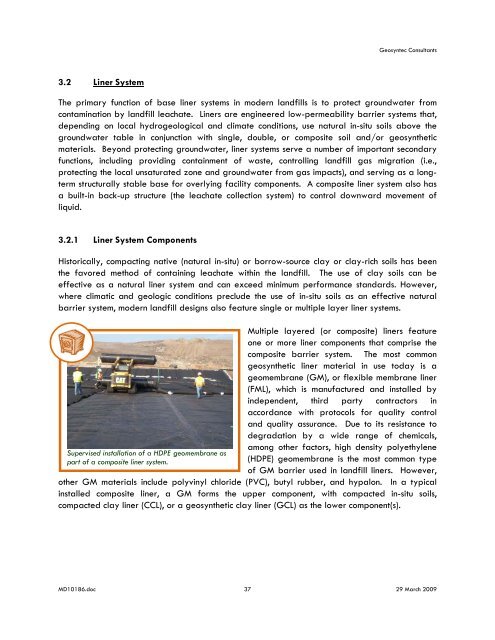AREA A/B ENGINEERING REPORT - Waste Management
AREA A/B ENGINEERING REPORT - Waste Management
AREA A/B ENGINEERING REPORT - Waste Management
Create successful ePaper yourself
Turn your PDF publications into a flip-book with our unique Google optimized e-Paper software.
3.2 Liner System<br />
Supervised installation of a HDPE geomembrane as<br />
part of a composite liner system.<br />
Geosyntec Consultants<br />
The primary function of base liner systems in modern landfills is to protect groundwater from<br />
contamination by landfill leachate. Liners are engineered low-permeability barrier systems that,<br />
depending on local hydrogeological and climate conditions, use natural in-situ soils above the<br />
groundwater table in conjunction with single, double, or composite soil and/or geosynthetic<br />
materials. Beyond protecting groundwater, liner systems serve a number of important secondary<br />
functions, including providing containment of waste, controlling landfill gas migration (i.e.,<br />
protecting the local unsaturated zone and groundwater from gas impacts), and serving as a longterm<br />
structurally stable base for overlying facility components. A composite liner system also has<br />
a built-in back-up structure (the leachate collection system) to control downward movement of<br />
liquid.<br />
3.2.1 Liner System Components<br />
Historically, compacting native (natural in-situ) or borrow-source clay or clay-rich soils has been<br />
the favored method of containing leachate within the landfill. The use of clay soils can be<br />
effective as a natural liner system and can exceed minimum performance standards. However,<br />
where climatic and geologic conditions preclude the use of in-situ soils as an effective natural<br />
barrier system, modern landfill designs also feature single or multiple layer liner systems.<br />
Multiple layered (or composite) liners feature<br />
one or more liner components that comprise the<br />
composite barrier system. The most common<br />
geosynthetic liner material in use today is a<br />
geomembrane (GM), or flexible membrane liner<br />
(FML), which is manufactured and installed by<br />
independent, third party contractors in<br />
accordance with protocols for quality control<br />
and quality assurance. Due to its resistance to<br />
degradation by a wide range of chemicals,<br />
among other factors, high density polyethylene<br />
(HDPE) geomembrane is the most common type<br />
of GM barrier used in landfill liners. However,<br />
other GM materials include polyvinyl chloride (PVC), butyl rubber, and hypalon. In a typical<br />
installed composite liner, a GM forms the upper component, with compacted in-situ soils,<br />
compacted clay liner (CCL), or a geosynthetic clay liner (GCL) as the lower component(s).<br />
MD10186.doc 37 29 March 2009

















